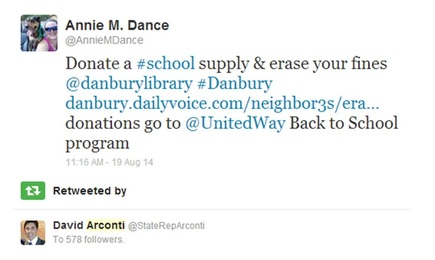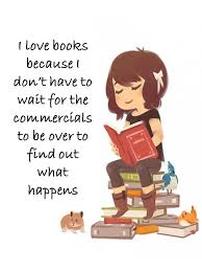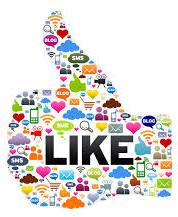"Books are the quietest and most constant of friends: they are the most accessible and wisest of counselors, and the most patient of teachers."
Charles W. Eliot (1834-1926), American Academic and Former President of Harvard University
Exposure to libraries and reasearch
What you're exposed to as a child shapes your world view, and everything, as they say, comes back around. I've worked in the nonprofit world for several years (see my resume for details), in fact I really started as a child. Like many children I attended local library story times and various events, but I was unlike many of my friends - I learned the Dewey Decimal system at a young age, and even during sleepovers in middle school I would be reading the latest historical biography. My grandfather, who owned a vast collection of National Geographic magazines and encyclopedias, said more often than not when I'd ask a question, "look it up." Both of my parents worked for libraries/nonprofits/authors - my mother worked as a Special Collections Librarian and archivist, most notably with the Uris Library at the Metropolitan Museum of Art (now the Nolen Library in the Ruth and Harold D. Uris Center for Education), and later for author William F. Buckley, Jr.
When I was 8-years-old I attended the American Library Association conference in Atlanta, where I went on many touristy outings (Coca-Cola factory!), but most memorable was being first in line to meet author Michael Blake, to have him autograph my copy of Dances with Wolves. Originally written as a spec script, it went unsold in the mid-1980s. However, Kevin Costner had starred in Blake's only previous film, Stacy's Knights (1983), and encouraged Blake in early 1986 to turn the Western screenplay into a novel to improve its chances of being produced. The novel version of Dances with Wolves was rejected by numerous publishers but finally published in paperback in 1988. As a novel, the rights were purchased by Costner, with an eye on directing it. Blake told me that he was impressed that an 8-year-old was such a big fan of grown-up material. I explained enthusiastically I loved the movie, and the book, and admittedly, I had a special interest since Kevin Costner's daughter's name is Annie too. Years later, during my junior year of college while an intern at a production company I worked on the Bravo show, Page to Screen: Dances with Wolves, among others, where I researched the book more thoroughly, giving me a greater appreciation for both the book and the movie - both available at the local library.
I am also very familiar with libraries from my experiences working with my father, Kevin McCarthy, who has been the Director of the Perrot Memorial Library in Old Greenwich, CT since 1998. The Perrot Memorial Library, established in 1904, is an independent public library, however the library shares a database, online catalog and internet service with the Greenwich Library. He founded McCarthy Associates, a library planning consulting firm in 2000. I have worked for him since my senior year of high school as needed, as a Marketing and Communications Library Planning Assistant, performing various marketing, communication and administrative duties to assist with McCarthy Associates' projects involving library planning, construction, and project management. My experience and exposure to libraries' challenges in various communities and my experience working in public relations and communications inspired me to write this Insights column.
When I was 8-years-old I attended the American Library Association conference in Atlanta, where I went on many touristy outings (Coca-Cola factory!), but most memorable was being first in line to meet author Michael Blake, to have him autograph my copy of Dances with Wolves. Originally written as a spec script, it went unsold in the mid-1980s. However, Kevin Costner had starred in Blake's only previous film, Stacy's Knights (1983), and encouraged Blake in early 1986 to turn the Western screenplay into a novel to improve its chances of being produced. The novel version of Dances with Wolves was rejected by numerous publishers but finally published in paperback in 1988. As a novel, the rights were purchased by Costner, with an eye on directing it. Blake told me that he was impressed that an 8-year-old was such a big fan of grown-up material. I explained enthusiastically I loved the movie, and the book, and admittedly, I had a special interest since Kevin Costner's daughter's name is Annie too. Years later, during my junior year of college while an intern at a production company I worked on the Bravo show, Page to Screen: Dances with Wolves, among others, where I researched the book more thoroughly, giving me a greater appreciation for both the book and the movie - both available at the local library.
I am also very familiar with libraries from my experiences working with my father, Kevin McCarthy, who has been the Director of the Perrot Memorial Library in Old Greenwich, CT since 1998. The Perrot Memorial Library, established in 1904, is an independent public library, however the library shares a database, online catalog and internet service with the Greenwich Library. He founded McCarthy Associates, a library planning consulting firm in 2000. I have worked for him since my senior year of high school as needed, as a Marketing and Communications Library Planning Assistant, performing various marketing, communication and administrative duties to assist with McCarthy Associates' projects involving library planning, construction, and project management. My experience and exposure to libraries' challenges in various communities and my experience working in public relations and communications inspired me to write this Insights column.
Did you know?
September is Library Card Sign-Up Month! Free promotional tools featuring this year's Honorary Chairperson Stan Lee now available at the official page, September is Library Card Sign-up Month.
If you’re looking for the heart of any community, look no further than the local library. It’s the one place in America where the doors are open to everyone, it is America’s great equalizer, providing everyone the same access to information and opportunities for success.
What is a public library?
Childrens’ books as sociological benchmarks. Check out this side-by-side comparison of the original 1963 version of Richard Scarry’s Best Word Book Ever and the revised version published in 1991.
But libraries are not just for books. Marketing is key for anything - be customer oriented and develop a primary purpose of selling your product. Public relations for libraries concentrates more on selling the library as a whole, developing a corporate identity or image, and disseminating a clear message to the community about library mission and goals. See this article for more details about public relations in libraries.
Definition: A library is an organized collection of sources of information and similar resources, made accessible to a defined community for reference or borrowing. It provides physical or digital access to material, and may be a physical building or room, or a virtual space, or both. A library's collection can include books, periodicals, newspapers, manuscripts, films, maps, prints, documents, microform, CDs, cassettes, videotapes, DVDs, Blu-ray Discs, e-books, audiobooks, databases, and other formats. Libraries range in size from a few shelves of books to several million items. A public library is a library that is accessible by the general public and is generally funded from public sources, such as taxes. It is operated by librarians and library paraprofessionals, who are also civil servants. In the United States there are a fair number of public libraries that are 501(c)(3) organizations, not tax-supported and whose employees are not civil servants.
There are five fundamental characteristics shared by public libraries:
1. They are generally supported by taxes (usually local, though any level of government can and may contribute)
2. They are governed by a board to serve the public interest
3. They are open to all, and every community member can access the collection
4. They are entirely voluntary in that no one is ever forced to use the services provided
5. They provide basic services without charge
Public funding has always been an important part of the definition of a public library. However, with local governments facing financial pressures due to the Great Recession, some libraries have explored ways supplement public funding. Cafes, bakeries, bookstores, gift shops and similar commercial endeavors are common features of new and urban libraries. In my community, the Danbury Library has recently opened the Innovation Center and provides a vast array of services, see their website for details.
But libraries are not just for books. Marketing is key for anything - be customer oriented and develop a primary purpose of selling your product. Public relations for libraries concentrates more on selling the library as a whole, developing a corporate identity or image, and disseminating a clear message to the community about library mission and goals. See this article for more details about public relations in libraries.
Definition: A library is an organized collection of sources of information and similar resources, made accessible to a defined community for reference or borrowing. It provides physical or digital access to material, and may be a physical building or room, or a virtual space, or both. A library's collection can include books, periodicals, newspapers, manuscripts, films, maps, prints, documents, microform, CDs, cassettes, videotapes, DVDs, Blu-ray Discs, e-books, audiobooks, databases, and other formats. Libraries range in size from a few shelves of books to several million items. A public library is a library that is accessible by the general public and is generally funded from public sources, such as taxes. It is operated by librarians and library paraprofessionals, who are also civil servants. In the United States there are a fair number of public libraries that are 501(c)(3) organizations, not tax-supported and whose employees are not civil servants.
There are five fundamental characteristics shared by public libraries:
1. They are generally supported by taxes (usually local, though any level of government can and may contribute)
2. They are governed by a board to serve the public interest
3. They are open to all, and every community member can access the collection
4. They are entirely voluntary in that no one is ever forced to use the services provided
5. They provide basic services without charge
Public funding has always been an important part of the definition of a public library. However, with local governments facing financial pressures due to the Great Recession, some libraries have explored ways supplement public funding. Cafes, bakeries, bookstores, gift shops and similar commercial endeavors are common features of new and urban libraries. In my community, the Danbury Library has recently opened the Innovation Center and provides a vast array of services, see their website for details.
Engage the community, expand your network and reach out to public officials
When I worked at Barnard College I was in charge of putting students "on hold" who had outstanding balances at the health center where I worked. The same practice was done by the college's library. The holds prevented registration and students would not receive transcripts or their diploma until the fines were paid. At a public library no such hold exists, therefore they need to come up with ways to collect, or alleviate fines. The Danbury Library recently held "Erase Your Fines" week. Officials waived the fines for any overdue materials returned with a school supply item for a needy child. The library donated all the school supplies it collected to the United Way of Western Connecticut's Back to School Program, which fills backpacks with school supplies for needy children. I helped get the word out with this tweet, that was re-tweeted by Connecticut State Representative David Arconti, Jr. (D-109). It's always nice when your tweet is re-tweeted, but especially when it's for a good cause to create more buzz and visibility in the community for an important initiative.
Libraries and communities
The three E's
While many community dynamics are at work, three are particularly important to building healthy and prosperous communities over the long term: economy, ecology, and equity—the three E’s.
While many community dynamics are at work, three are particularly important to building healthy and prosperous communities over the long term: economy, ecology, and equity—the three E’s.
- Economy is the management and use of resources to meet household and community needs.
- Ecology is the pattern of relationships between living things and their environment. We all know our shoe size. How many of us know the size of our “ecological footprint,” the amount of air, land, and water it takes to support us?
- Equity is fairness. Ideally everyone in a community shares in its well-being. Where there is equity, decisions are based on fairness and everyone (regardless of race, income, sex, age, language, sexual orientation, or disability) has opportunities and is treated with dignity.
“The public library has been called ‘one of the seven sustainable wonders of the world.’ The written wisdom of the world at the fingertips of anyone with a library card! The average American pays $20 a year in taxes to support public libraries and can save that much by borrowing instead of buying just one or two books. A book that is loaned ten times cuts not only cost but paper use per reader by a factor of ten.”—Donella H. Meadows, Dartmouth College
Libraries and Technology
Libraries provide an invaluable resource for job seekers, as many patrons rely on the library as their only means of accessing the internet.
Check out 65 reasons to love your library here. Thanks to the Texas Library Association for their helpful tips and toolkits found here, here, and here.
Libraries provide an invaluable resource for job seekers, as many patrons rely on the library as their only means of accessing the internet.
- Almost 89% of public library outlets now offer wireless Internet access. According to the FCC, over 80 percent of Fortune 500 companies require that a job application be completed online. Patrons turn to library computers and Internet access to find work, apply for jobs online, type resumes and cover letters and open email accounts.
- Nearly 73% of libraries are their communities' only source of free computer and Internet access. This number increases to 82% in rural areas.
- Libraries help bridge the divide between those who have access to information and those who do not. Families making less than $15,000 annually are two to three times more likely to rely on library computers than those earning more than $75,000.
Check out 65 reasons to love your library here. Thanks to the Texas Library Association for their helpful tips and toolkits found here, here, and here.
What does the data say?
Survey data suggests the public values free public libraries. A 2013 Pew Research Center survey reported that 90% of Americans ages 16 and older said that the closing of their local public library would have an impact on their community, with 63% saying it would have a “major” impact. Over 50% of Americans have used a public library in the past 12 months. Among all Americans who have ever used a public library:
- 94% said that based on their own experiences, they would say that “public libraries are welcoming, friendly place."
- 91% said that they personally have never had a negative experience using a public library, either in person or online.
- 67% said that the public library nearest to where they live could be described as a “nice, pleasant space to be”; another 22% say it’s an “okay space, but could use some improvements.”
Final thoughts
Libraries serve the public, whether that public is defined as a school population or whole communities. In many ways, libraries are an organic creation of public needs—social, intellectual, educational, economic, and entertainment. Libraries offer incredible products and services—and those services are free! Given all this, libraries should have no difficulty developing a strong buy-in from their public and enjoy incredible support and recognition, right?
While study after study shows that the public has great respect for libraries as institutions, garnering support in tangible form is often a challenge. The reason for this is simple: the public does not understand the actual (fiscal and social) support needed to make libraries—to make their library—vital and strong. The public often does not translate their philosophical appreciation of libraries to a personal connection with what their library can do for them, and correspondingly, they can do for their libraries.
Public relations and communications are central in bridging that gap. Beyond promoting existing library services, public relations is about making the library’s mission relevant and important to the people that library serves. As with all mission-driven functions, public relations is best delivered when it is carefully planned and directly related to the goals of the organization.
While study after study shows that the public has great respect for libraries as institutions, garnering support in tangible form is often a challenge. The reason for this is simple: the public does not understand the actual (fiscal and social) support needed to make libraries—to make their library—vital and strong. The public often does not translate their philosophical appreciation of libraries to a personal connection with what their library can do for them, and correspondingly, they can do for their libraries.
Public relations and communications are central in bridging that gap. Beyond promoting existing library services, public relations is about making the library’s mission relevant and important to the people that library serves. As with all mission-driven functions, public relations is best delivered when it is carefully planned and directly related to the goals of the organization.
What do you think about libraries? Leave me a comment or tweet me @AnnieMDance with #insightsintolibraries
.........................................................................................................................................
Are you or someone you know in need of social media/PR/marketing/other help? Please email me, and let's connect on Linkedin, and follow me on Twitter. I'm available for full-time or freelance work.
.........................................................................................................................................
Are you or someone you know in need of social media/PR/marketing/other help? Please email me, and let's connect on Linkedin, and follow me on Twitter. I'm available for full-time or freelance work.







